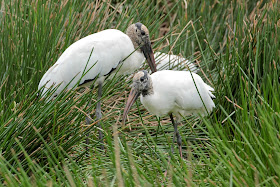I came across 10-12 wood storks on the 17th hole of my golf course, so, after finishing,
I hurried back to the house to pick up a camera with a telephoto lens.
Wood storks are big white wading birds with long beaks and gnarly necks and heads.
They were categorized until 2014 as "endangered" but are now categorized as "threatened."
Yesterday there were fewer wood storks, and they were joined by roseate spoonbills.
Beautiful birds.




Nice of the birds to stick around until you got back with the zoom lens. Did you do any birdies during your round of golf?
ReplyDeleteA new meaning to 'birdies' on the golf course. What lovely birds, glad to hear they are 'coming back' and those pretty pink ones are spectacular.
ReplyDeleteThat was very nice for them to stay while you retrieved your camera. They know what's important and now they are seen around the world. :)
ReplyDeleteThose birds were very cooperative; lovely photos and good info, Jack.
ReplyDeleteI'm so glad you went back for your camera. These are great shots. I don't think I've ever seen this kind of stork before. I have seen the roseate spoonbills down in Costa Rica. They are such a beautiful color.
ReplyDeleteHow thrilling to spot so many of these storks, Jack! I remember seeing a colony at the Corkscrew Reserve and the noise they made was amazing. Glad they are coming back.
ReplyDeleteJack, these are amazing bird photos. I have never seen either of these birds, and yes, I have spent some time in Florida. That is a coup to have threatened wildlife at your water hazards.
ReplyDeleteNice of them to stick around until you got back! lol The spoonbills are just gorgeous.
ReplyDeleteLovely pictures, well captured. Thanks for sharing.
ReplyDeleteI'm not a nature photographer but I can imagine the pleasure of encountering this more-or-less in the neighborhood.
ReplyDeleteThey really look like characters.
ReplyDeleteNice and interesting birds.
ReplyDeleteStorks and spoolbills! I don't think I've ever seen either "in the feather." Great closeup shots! It's nice to see the details of those "gnarly necks and heads." (Audubon terminology, right?)
ReplyDelete